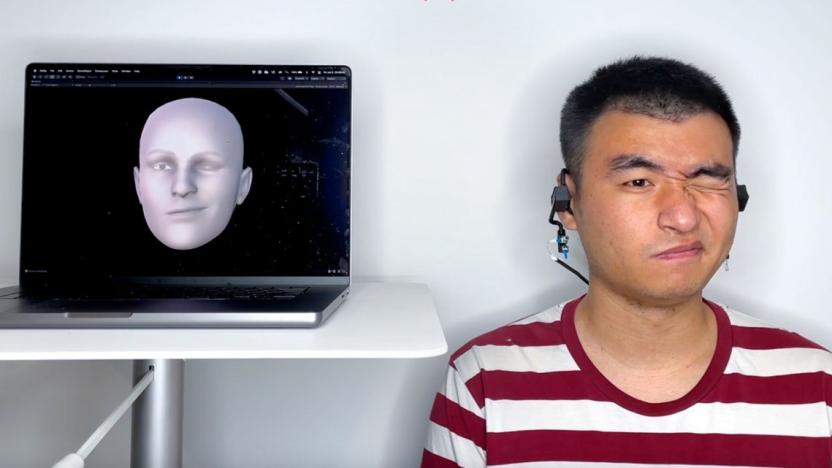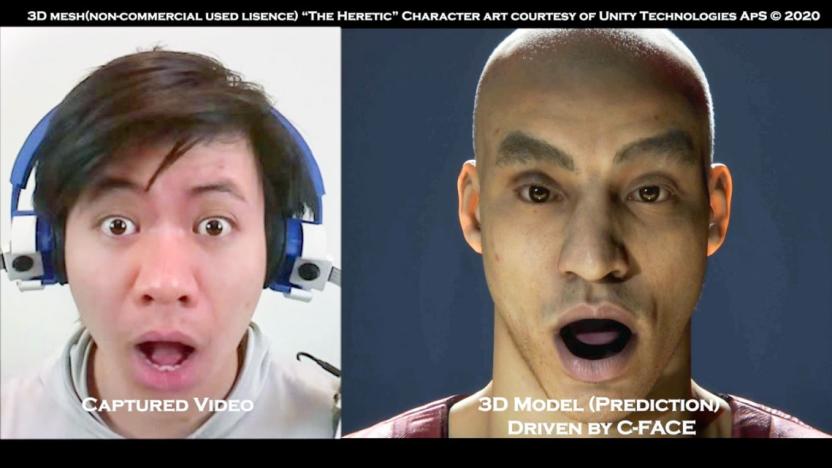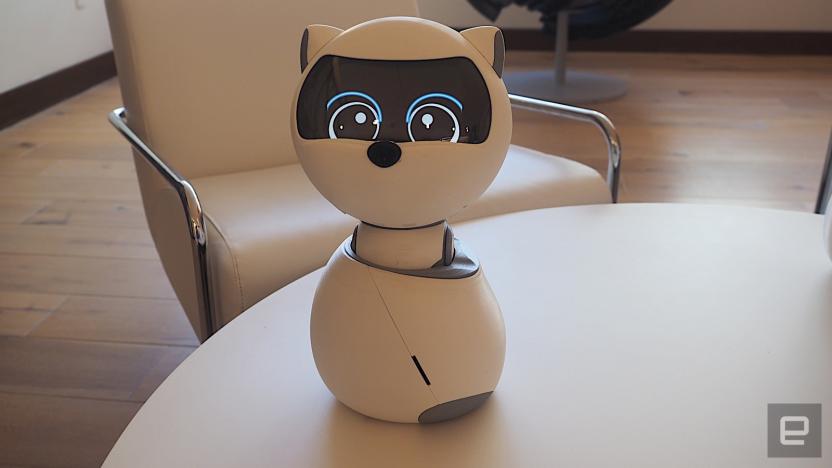face tracking
Latest

Researchers made a sonar-equipped earphone that can capture facial expressions
The 'earable' bounces sound off the inside of the wearer's cheeks to detect face movements.

Cornell researchers created an earphone that can track facial expressions
The team says C-Face works even when the subject is wearing a mask.

Snapchat Cameos lets you insert your face into a GIF
Snapchat's secret weapon is its uncanny face-swapping and -tracking algorithms, and it has just deployed those to great effect in a new chat feature called Cameos. The feature, which leaked out yesterday, inserts your selfie into short, looping videos featuring cats, shopping carts, cars and more. The idea is to send your pals an expressive GIF, starring... you.

Kiki the social robot is a mechanical animal who wants to be your friend
Not everyone has the space, money or quite honestly patience to foster a rambunctious Aibo. But that doesn't mean you'll have to spend the rest of your days alone. The forthcoming Kiki from Zoetic AI offers an equally rewarding and, with a $1499 price tag, slightly more affordable domestic robotic pet experience without all the servo noise.

Microsoft job posting hints at Connected Car strategy: Azure, Kinect and WP8
Redmond seems to have more grandiose ideas for Connected Car than it's let on before, judging from a recent help wanted ad on its site. Reading more like PR for its car-based plans, the job notice waxes poetically about using "the full power of the Microsoft ecosystem" in an upcoming auto platform with tech such as Kinect, Azure, Windows 8 and Windows Phone. Those products would use face-tracking, speech and gestures to learn your driving habits and safely guide or entertain you on the road, according to the software engineer listing. It also hints that everything would be tied together using Azure's cloud platform, so that your favorite music or shortcuts would follow you around, even if you're not piloting your own rig. All that makes its original Connected Car plans from 2009 seem a bit laughable -- check the original video for yourself after the break.

SOEmote tracks our face, transplants our expressions onto an Everquest II persona (faces-on)
Sony's PlayStation division may have been the main focus this week at E3, but Sony Online Entertainment has something unique of its own to show off for MMORG players. Specifically, folks who are into the PC title Everquest II will soon be able to access a facial recognition feature called SOEmote (S-O Emote). It's no secret that these types of games require massive amounts of communication between players, and SOEmote is an attempt to make in-game conversations more personal than ever. Utilizing any webcam, the software is able map and track your noggin at 64 points, allowing your onscreen character to replicate any facial movements you make. We got a chance to mess around with a beta version of the software, and the results are impressive to say the least -- pretty much all of our facial expressions were accurately recreated. Join us past the break for more details and a hands-on faces-on video demo of it in action. %Gallery-157578%

Perifoveal Display tracks head positioning, highlights changing data on secondary LCDs (hands-on)
If there's a large display as part of your workstation, you know how difficult it can be to keep track of all of your windows simultaneously, without missing a single update. Now imagine surrounding yourself with three, or four, or five jumbo LCDs, each littered with dozens of windows tracking realtime data -- be it RSS feeds, an inbox or chat. Financial analysts, security guards and transit dispatchers are but a few of the professionals tasked with monitoring such arrays, constantly scanning each monitor to keep abreast of updates. One project from the MIT Media Lab offers a solution, pairing Microsoft Kinect cameras with detection software, then highlighting changes with a new graphical user interface. Perifoveal Display presents data at normal brightness on the monitor that you're facing directly. Then, as you move your head to a different LCD, that panel becomes brighter, while changes on any of the displays that you're not facing directly (but still remain within your peripheral vision) -- a rising stock price, or motion on a security camera -- are highlighted with a white square, which slowly fades once you turn to face the new information. During our hands-on demo, everything worked as described, albeit without the instant response times you may expect from such a platform. As with most Media Lab projects, there's no release date in sight, but you can gawk at the prototype in our video just after the break.

Toshiba's 4K, glasses-free 3DTV announced in Japan with more specs this time
We first saw the retail edition of Toshiba's 3840x2160 resolution autostereoscopic (no glasses) 3DTV when it was announced in Europe at IFA last month, and now it has debuted in Japan during CEATEC. This time the company dropped a few more details, revealing that in lenticular 3D mode it's limited to an effective resolution of 1280x720, and showed off the face tracking that automatically optimizes the experience for up to nine simultaneous viewers depending on where they're sitting. Also mentioned were an optional THD-MBA1 input adapter due in 2012 and that 4K-res streaming IPTV is currently being tested. The Regza 55X3 will be priced comparably to its $10K~ Euro-spec counterpart when it arrives in December, but there's still no word on when it will ship in the US. Check out a few pictures of the presentation in the gallery below. %Gallery-135528%

Microsoft's OneVision Video Recognizer can detect, identify, and track your face on video... so smile!
Here's your classic case of "just because you can, doesn't mean you should." Microsoft's Innovation Labs have just demonstrated a OneVision Video Recognizer algorithm that's powerful enough to perform face detection duties on a running video feed. It can recognize and track humanoid visages even while they're moving, accept tags that allow auto-identification of people as they enter the frame, and can ultimately lead to some highly sophisticated video editing and indexing via its automated information gathering. Of course, it's that very ease with which it can keep a watchful eye on everyone that has us feeling uneasy right now, but what are you gonna do? Watch the video after the break, that's what.

Evigroup Paddle tablet goes Pro, gets cursor-controlling, head-tracking webcam
Some day, in the distant future, we'll be activating windows, clicking buttons, and playing Farmville with our minds. Our minds. There have been attempts to get us there, none fully comprehensive, though the Evigroup Paddle Pro tablet is taking an interesting alternative approach: using head tracking to control the cursor. Apparently its front-facing webcam detects your front-facing mug and as you look about the screen it moves the cursor appropriately. Staring rudely at any button or control for a half-second equates to a click and, while we don't yet know how you'll double-click, we'd like to think a spasmodic twitch will be required. Evigroup is also launching a curvy keyboard to go with the Paddle Pro and is promising the ability to play video and audio wirelessly courtesy of a "small station" that connects to your TV. The internals, meanwhile, are perfectly predictable: a netbook spec Atom N450 struggling with Windows 7 Home Premium. No word on price or availability.

Nintendo DSi game lets your face do the flying (video)
When it comes to video games that make you look absolutely ridiculous, nothing beats Microsoft's Kinect, but Nintendo's got a substitute if you just can't wait. The aptly-named Face Pilot: Fly With Your Nintendo DSi Camera! does exactly that, letting you literally direct a virtual hang glider with your face, by using the Nintendo DSi's camera to track your head in 2D space. Sure, Sony's EyeToy did similar things earlier this decade and you could program Windows-based FreeTrack software to do the same, but neither provide the portable hilarity (or challenge) of Face Pilot played on commuter rail. The downloadable title will set you back 500 Nintendo Points ($5) at the DSiWare store; watch a quick video demo after the break.

Microsoft hints at touchless Surface combining camera and transparent OLED (video)
We've always wondered whether Microsoft's multitouch table would actually ever arrive, dreaming of Minority Report hijinx all the while, but after seeing what the company's Applied Sciences Group is currently cooking up -- a touchless telepresence display -- we'd rather drop that antiquated pinch-to-zoom stuff in favor of what might be Surface's next generation. Starting with one of Samsung's prototype transparent OLED panels, Microsoft dropped a sub-two-inch camera behind the glass, creating a 3D gesture control interface that tracks your every move by literally seeing through the display. Combined with that proprietary wedge-shaped lens we saw earlier this month and some good ol' Johnny Chung Lee headtracking by the man himself, we're looking at one hell of a screen. Don't you dare read another word without seeing the prototype in a trifecta of videos after the break.

Video Kinect: video chat and stream sharing over Xbox Live and Live Messenger
Xbox Live and Windows Live Messenger are about to meet up in a very personal way -- Microsoft has just announced a new video chat service called Video Kinect, which serves as a logical extension of its brand new Kinect voice- and motion-sensing control system. But it's not just video calling, no sir, you'll be able to watch movies, news, sports, and the like together with whoever you're chatting with. Additionally, thanks to a motorized base and a new skeleton-tracking feature, the Kinect unit will also follow users as they move around the room. Yup, not creepy at all.

Microsoft's new lens tracks your face, steers 3D images to your eyes (video)
Glasses-free 3D has taken several forms, but most have a critical flaw -- viewers have to stand in predefined locations to get the effect. That just won't do, so Microsoft's prototyped a new approach, and it's one of the wildest we've seen. Taking a cue from Project N... we mean Kinect, cameras track the face while a special wedge-shaped lens traps bouncing light, and after the beams have reached a "critical angle," it exits towards the viewers eyes, aimed by programmable LEDs at the bottom of the screen. Since the system can beam a pair of simultaneous images to two different places, the obvious use is stereoscopic 3D, but researchers found they could also send different images to different viewers, as a sort of privacy screen. If that sounds far fetched, you're not alone -- but you'll find a video proof-of-concept at the more coverage link.

Pricing for Sony's 2010 3DTVs revealed at JR.com
We've been eagerly waiting for some US pricing info on Sony's upcoming 3DTVs, and while SonyStyle still shows only a grim "notify me," JR.com is listing pricing information for the LX900, HX900 and HX800 series LCDs. As usual, preorder pricing on sites like this can shift, but at the moment $1,799 nabs a 40-inch LED edge lit XBR-40LX900 with integrated 3D emitter, WiFi and face-tracking, all the way up to the 60-inch version at $3,779. The HX900 (LED backlit) and HX800 (LED edge lit) are both "3D capable," requiring a separate emitter plus the requisite glasses to get down with the extra dimension and falling in somewhere in between in terms of price. The ship date is only mentioned as "coming soon," but at least now you know how many pennies to roll up before heading out to the store some time this summer. [Thanks, Ali]

A peek (and head tilt) into the future: head-tracking in FPS games
Move over Johnny Lee. Now that you've gone corporate, there's a new student researcher in town ready to take up your mantle. What mantle is that, you ask? The "show us cool tech that can be used in video games via YouTube" mantle, of course. Introducing Torben Sko, a PhD candidate at Australian National University. He's currently "studying the idea of augmenting traditional forms of computer game interaction using unconventional, but commercially viable approaches." Translation: head- and face-tracking in video games using a traditional webcam. The video after the break shows off several very impressive demonstrations of this technology using none other than Half-Life 2's Source engine: 1) VR Desktop is a "replication of the [technique] made popular by Johnny Lee"; 2) Zoom in by moving your head closer to the screen; 3) Peering allows you to look around the corners by tilting your head; 4) Camera rotation/spinning allows you to look around, "more like a Handycam"; 5) Ironsighting "allows the player to aim down the barrel of their weapon by tilting their head to the side." If you're anything like us, you're already imagining this functionality in games using both the Xbox Project Natal camera and the PlayStation Eye. Afraid that new camera-based interfaces herald the death of traditional gameplay? ("I don't want to play Halo Reach by jumping up and down!") Fear not! This video is whispering in your ear, Core Gamer, and saying, "Don't be afraid. Everything is going to be alright." [Via PushingPlay]

Norcent cranks out 10-megapixel DCS-1050 camera
Norcent's done 10-megapixels on the cheap before, but apparently, one just isn't enough. Announced today, the DCS-1050 (part of the firm's new 50 Series) will be showcased at CES and will boast a 10-megapixel sensor, a 3-inch "scratch-resistant" LCD monitor, face-detection / anti-shake capabilities, a 3x optical zoom (along with 4x of the practically worthless digital kind), red-eye reduction and 22 scene modes. Additionally, the unit even includes voice recording functionality, 16MB of internal memory, an SD / MMC expansion slot, USB / AV ports, and an MPEG-4 video capture mode that supports resolutions up to 640 x 480. Unfortunately, Norcent is trying to keep a straight face while slapping a $179.99 price tag on this thing, which just seems a touch absurd for the features, no?

BenQ offers up 10 megapixel E1000 point-and-shoot
With BenQ executives somewhat preoccupied with keeping their own asses out of jail, and the company's camera division having been turned over to Ability Enterprises at the end of June, it's hard to say who's really responsible for the latest camera to bear the troubled Taiwanese manufacturer's name. Whoever designed the 10 megapixel DC-E1000, though, seems to have done a pretty good job, taking a cue from the handsome design of the P860 and adding such desirable features as face tracking (up to nine people), a 3-inch LCD, and digital image stabilization. Other specs -- like the 3x optical zoom and claimed 1600 max ISO -- are certainly nothing groundbreaking, and we're assuming that pricing will reflect that fact when these go on sale in China later this month.[Via Let'sGoDigital]

Philips unveils SPC620, SPC1000, and SPC1300 webcams at Computex
While we thought we'd already seen the crown jewel of webcams before, Philips apparently thinks otherwise, as it boasts quite heavily about its new trio of display-mountable cams that were unveiled at Computex. All three devices support background customization and emoticon integration, wide-angle lenses, and face-tracking capabilities. The SPC620 holds down the low-end with a vanilla VGA CMOS sensor and will run you €49.90 ($67), while the SPC1000 includes a directional microphone and noise reduction filter, two-megapixel sensor, and a 5x digital zoom for the very same price. The €99.90 ($135) SPC1300 features Pixel Plus 2 technology seen in the company's Flat TVs, a six-megapixel sensor, audio beaming system, twin directional microphones, and Digital Natural Motion technology that purportedly nixes any frame rate flickers when video chatting. All three webcams should hit shelves in Europe, America, and Asia this August.[Via TechDigest]

KornTech's Rogun robot recognizes faces and intruders
While KornTech's Rogun won't go down as the first humanoid that sports both face recognition and intruder alerting functions, it does one-up many of the other prototypes by actually being available for purchase. The Korean startup has developed a kid-friendly one-meter-tall robot that "recognizes people through embedded cameras and high-end face-tracking software." Additionally, the bot can walk on its own and "perform various functions suitable for a security guard or nanny" such as pace the floors at night and give its master a cellphone warning if it recognizes any suspicious behavior. Rogun can even use its camera to show parents what mischief their kids are getting into at home by beaming video via its integrated WiFi chipset, and if watching the big screen is just too 2006, the youngsters can focus on the seven-inch LCD set within the device's chest. Of course, video telephony, internet browsing, and priceless companionship also come bundled in, and while the company hopes to sell these fellows for a mere $5,000 in time, snapping up your own Rogun at the moment will run you a whopping $100,000 or so considering the current BTO nature of production.[Via I4U]








